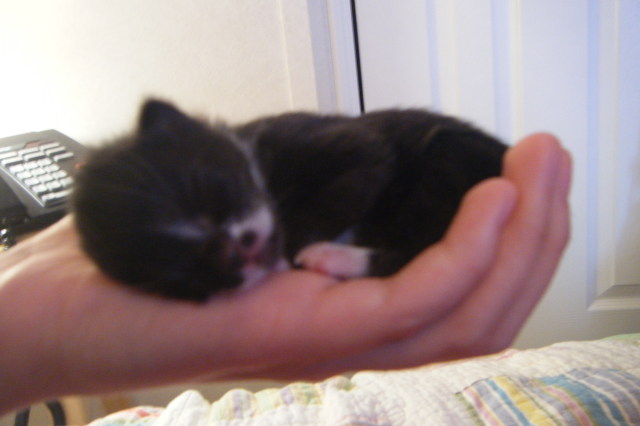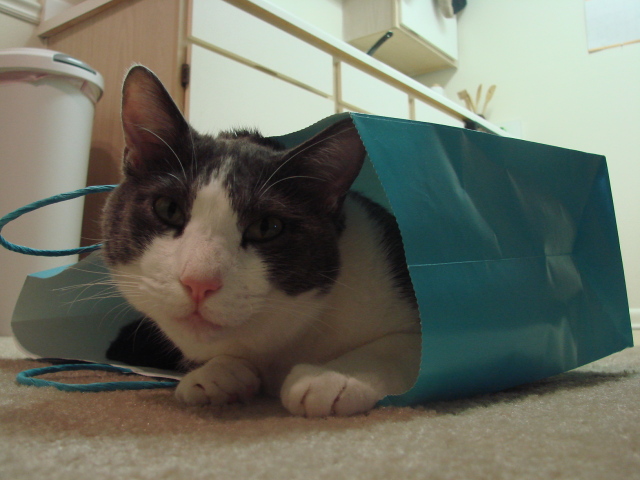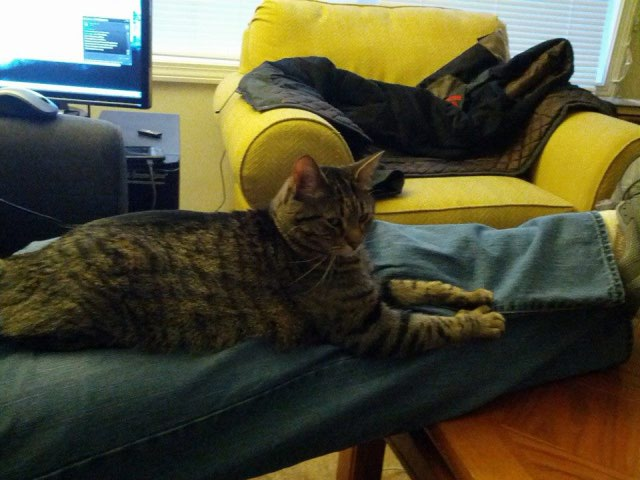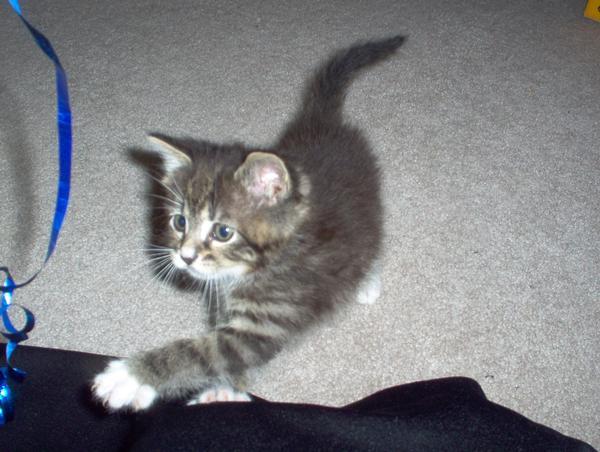QuestionQuestion #1 is Re the possibility of masitis in my 11 mo old new queen. To clarify, the problem is in her last 2 teats at the bottom that are swollen internally. One has a hardness under the skin about the size of an large egg yolk. The other is about half that size. They are very pink. Fortunately she only had 4 kitties, so there's no one without a teat. Mother seems healthy, is eating, drinking, going to the "toilet" and doesn't seem to be in any pain, even when I manipulate the teats. I have been putting warm compresses on whenever I get a chance, which is not too often, 3/day, as I'm pretty busy. This is my daughter's cat, and she is away. SO, I'm hoping that it is not mastitis. The kitties weighed on the average of 130 grams on the second day.
The vet will be open tomorrow, but I'm hoping that it won't be necessary. Somehow I can't see how I would get mother and kitties to the vet without trauma, and keep them warm; but I suppose that I can swaddle the carrier cage with many warm blankets before the trip, 10 miles to town, and keep the heater on full blast.
2. The second problem is that the mother/queen's sister is also accidentally pregnant as well, (APOLOGIES FOR THIS.), and I think is broody. She helped with the delivery of her sister's kitties and perhaps she thinks that one is for her. (I don't begin to know what's going on in their minds.) She insists on being with her sister as much as possible. I do this now only under supervision, as I saw her on the first day take a kitty for herself and sequester it in another dark warm area of the room. I noticed right away that one was missing; but the kitty was not crying, so Mom had not been alerted. I have now caught her doing this many times. She lays in the pose of feeding but since she has no milk, it is very sad. On the other hand, she may deliver any day now, and will have her own brood.
#3. Can I have both mothers in separate beds in the same room? We have a pretty small house and 3 other full grown cats. I'd like to confine the nursery to one room , if possible. Thanks in advance. Barbara
AnswerBarbara,
Ultimately there's no way to know for sure if your nursing queen's got mastitis unless she's examined by a vet. I do think that it would be wise to have the new mom and her offspring checked over just to make sure that there's nothing serious going on that would affect the survival or health of mom or her kittens. The warm compresses should help to alleviate the discomfort of engorged or infected mammary glands, but if mom has mastitis the kittens shouldn't be nursing from her because the bacteria in the milk isn't good for them. It sounds to me like the kittens are nursing well and putting on weight at a reasonable rate, so it's certainly possible that mom's just engorged with loads of extra milk, but I am concerned about the hard swellings in a couple of her nipples.
As for the behavior you're seeing with the new mom's sister it's not uncommon. In feral cat colonies or barn cats related females will often care for and nurse each other's kittens. There's absolutely nothing wrong with keeping the nursery confined to one room and allowing all of the kittens to be cared for by both moms. It's quite possible that the pregnant queen has some milk so the kittens she takes are probably still nursing quite well. It's very important to keep the moms and their babies isolated from the other cats in the household particularly if there are intact male cats in your home because they can seriously injure or kill young kittens because that will cause mom to cycle back into estrus more quickly and be receptive to mating sooner than she would be if she'd raised her babies on her own.
There are a number of opinions about how old kittens should be when they leave their mother and move into adoptive homes. I've cared for many kittens over the years and in my experience kittens who stay with their mother for the first 12 weeks are less likely to have certain health and behavioral issues. It really is best if mom cares for her kittens til they're at least 12 weeks old, by that time they're less fragile, they've been eating solids for awhile, they won't usually suffer from low blood sugar (can happen quite suddenly in kittens 9 weeks old or younger and it can be fatal if not discovered in time) and by the age of twelve weeks kittens have learned some basic etiquette in terms of how they socialize with other cats and their human caregivers.
Although young kittens are cute it's important that you play the role of helping socialize them with people so that they behave appropriately and have a better chance of living in a permanent home. Never allow any kitten, no matter how adorable to chew any of your possessions and never ever permit a kitten to bite, scratch or attack any part of your body - this includes hands, feet, fingers and toes under the blankets at night. Kittens should be taught that they can play with mom, their siblings and toys. If kittens think that biting or scratching is a game it can cause their adoptive family to euthanize, abandon or admit their cat to a shelter because they're worried that their cat may hurt someone. In North America the leading cause of death in cats is euthanasia due to behavioral problems, some problems are completely preventable by properly socializing cats when they're kittens, others are prevented or reduced in intensity by spaying/neutering kittens as early in life as possible.
Newborn kittens have very little resistance to infection so it's important to keep the moms and their babies away from any other pets and be sure that anyone who handles this little family takes time to thoroughly wash their hands in hot, soapy water to reduce the likelihood of passing along some sort of infection. During the first 12 weeks of a kitten's life is when they're growing most rapidly and they also learn important skills including how to defend themselves, how to stalk, pounce on and kill prey, how to interpret feline body language and respond appropriately. The first 12 weeks of a kitten's life also include milestones such as potty training, eating solid food and learning skills like bite inhibition and learning how to use their sharp claws/teeth on toys and scratch pads/posts. It's never okay to allow a kitten to bite or scratch any part of any person's body that's an important part of their socialization and development. Proper socialization and handling will help to ensure that these baby predators are as adoptable as possible.
Unlike dogs nursing queens don't require any human help to wean their kittens, this normally happens around 6-8 weeks of age, but kittens should definitely be weaned some time in the first 12 weeks of life. I would recommend providing moms and their newborn families with a comfy bed made from a cardboard box lined with old towels or a blanket, the box should be large enough for the moms and their babies to stretch out and nurse comfortably, have low enough sides that moms can come and go easily and have high enough sides to prevent the tiny newborns from wandering off on their own. I recommend against ever allowing a mom and her newborn kittens sleeping in bed with any person because kittens are easily suffocated if we accidentally roll onto them.
Mom should have access to as much fresh water as she likes, she should also have as much of a high quality, holistic cat food made from human grade ingredients as she wants. I've found that Wellness and Spot's Stew by Halo are good quality foods and they're made from human grade ingredients. Wellness is meant to be fed as a combination of canned and dry food which can be a bit pricey. I feed my cats Spot's Stew Sensitive Cat by Halo, a 6 lb bag costs roughly $25 and lasts my 3 resident cats about a month. You can choose to feed canned food, dry food or any combination you like. Mom's food intake can double, triple or even quadruple in some cases while nursing kittens because she has to meet her own nutritional needs as well as those of her rapidly growing family. High quality foods may initially appear expensive when compared to brands sold in grocery/discount stores. When cats are fed a high quality food they tend to eat less because they don't need as much food to meet their nutritional needs. Litter box deposits are less frequent and less pungent. Cats who are fed high quality foods have fewer health problems which means that you spend less money at the vet's office. Another advantage to high quality nutrition for your cat is that she'll likely live a much longer, healthier life.
Kittens learn about things like litter training, using scratch posts and how to interact politely with people from their mother.
When the kittens start being more mobile (2-3 weeks of age) it's a good idea to start making some kitten sized litter pans available - a cheap, easy and disposable solution is to use aluminum pans with low sides from the grocery store, the ones meant for baking are best, the lower the sides are the sooner the kittens will begin to explore their litter pans. I would recommend that you use a non toxic kitty litter such as one made from wheat or corn to ensure that the kittens won't become sick if they eat the litter and many do, at least initially. As the kittens see mom using a litter pan they will eventually copy her in most cases. Sometimes it's easiest to gently get the little ones using their paws to scratch and dig in the litter and then you or mom can gently stimulate them to urinate/defecate by using a cotton ball lightly moistened with warm water to gently wipe the kitten from genitals to bottom which will help reduce the likelihood that the little one will develop a urinary tract infection. Once the kittens are able to smell urine/feces in the temporary kitten litter pans they will begin to use the litter rather than squatting where they happen to be at the time the urge to go to the toilet hits them.
There's a serious pet overpopulation problem affecting shelters and rescue organizations worldwide and all too often shelters are forced to euthanize healthy, adoptable animals because they run out of time, space and resources to devote to each animal. Spaying and neutering pets has many medical and behavioral benefits aside from the obvious benefit of population control. Spaying and neutering cats prevents uterine, ovarian and testicular cancers. The earlier in life a cat is sterilized the lower their risk is of developing prostate or breast cancer. Unspayed female cats are at risk of developing a potentially life threatening uterine infection called pyometra which causes the womb to fill with pus - if the uterus ruptures and infection spreads throughout the abdomen the cat's chances of survival aren't good. The only treatment for pyometra is to spay the cat although doing so while she has such a serious infection increases the risks during surgery and the financial cost is higher because the surgery takes longer and is more complicated. In North American cats the leading cause of death is euthanasia secondary to behavioral problems. Spaying and neutering cats prevents serious behavioral issues such as using urine/feces to mark territory inside and outside of the house, fighting with other cats (which can result in some pretty expensive vet bills to treat abscesses and other fight wounds), wandering away from home in search of other intact cats to mate with, caterwauling to decide which male gets the right to breed with specific females in season, howling to advertise their availability to mate and sterilizing cats also reduces the likelihood that they'll develop issues with aggression. Spaying and neutering is a responsible and ethical choice that saves countless lives every year.

 I think my kittens got into our horses oats (with seed hulls)
Question
Our newborn baby :)
Hi there,
My kittens are
I think my kittens got into our horses oats (with seed hulls)
Question
Our newborn baby :)
Hi there,
My kittens are
 Cat behavior question...
QuestionZero the goofball
QUESTION: Hi Kate,
I
Cat behavior question...
QuestionZero the goofball
QUESTION: Hi Kate,
I
 Chinese Li Hua?
Question
Magnus1
Hi,
My husband and I recently
Chinese Li Hua?
Question
Magnus1
Hi,
My husband and I recently
 my kitty Valentine
QuestionQUESTION: my kitten is 3 month old I only had h
my kitty Valentine
QuestionQUESTION: my kitten is 3 month old I only had h
 runts
Question
stubby(my cat)
Can the mother chew off
runts
Question
stubby(my cat)
Can the mother chew off